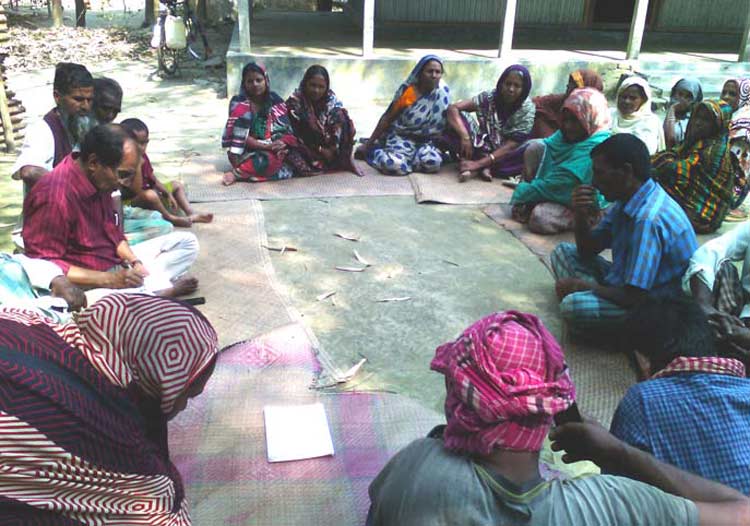Safe food production: Nayakrishi farmers’ perception

On 9th March, thirtytwo farmers, daimas, poultry keepers, students, women, vegetable traders of five villages of Atia Union of Delduar Upazilla in Tangail me in a meeting held in Nanduria village to discuss how to assess food safety of the crops they produce. They are very active farmers growing food crops without use of any chemical fertilizers and pesticides for over 20 years.
They grow various crops including cereals, pulses, vegetables, oil seeds and fruits. Cereals include rice, wheat, barley and maize; pulses such as black gram, grass pea, lentil and pea; oil seeds such as rye, mustard and sesame; vegetables including okra, amaranth, potato, sweet gourd, ash gourd, Indian spinach, spinach, tomato, snake gourd, sponge gourd, string bean, red amaranth, water gourd, common bean, arum, radish, cauliflower, cabbage, brinjal, papaya, and jute leaf. Farmers produce spices including onion, garlic, coriander, turmeric, ginger, radhuni, aniseed and chili; fruits mango, jackfruit, litchi, papaya, banana, Indian olive, guava, hog’s plum, plum, wood apple, four varieties of banana (sagar, sabri, madna, bichi), pomelo, tamarind and star fruit. With a safe environment they get various uncultivated food and spinach such as henchi, gima, baita, dondo kolosh, kolmi, dheki, kochu, morog, natapata, helencha, telakucha, kharcon, pipul, kanai, khuira kata, and bhulbuira sak. Poultry (hen and ducks) and livestock (cow and goat) are part of their farming activity.
As the farmers are mostly marginal and small farmers the use the farm produced food crops for a. own family consumption, b. distribution among the relatives, c. selling among neighbors, d. selling in local markets, and e. selling to the whole sellers.
Safety of food depends a lot on how it is produced. But there are a number of other issues that the farmers are aware of. These are: 1. safe soil (according to Farmers’ perception, the safe soil means it is free from chemical fertilizer and pesticide), 2. self-involvement in cultivation (the farmer is confident of food safety, that is raised on his/her own land and cultivated by themselves); 3. use own farm saved seed (the Farmer is sure about the quality of the seed saved from own crops, 4. ecological production (use cow dung , ash, compost, oil cake only and no use of chemical fertilizer and pesticides); 5. use crop residue for mulching, 6. slight infestation of pests (crops raised without pesticides may have sporadic attack of pests which are dealt with pest repellent plants or organic pesticides. slight attack by pest is an indication of safety from chemicals).
These are some of the own assessments of safety of food crops. However, this is only upto production in the land. The next step is consumption and marketing. ‘Crops raised with my own hand on my own land are safe’, mentioned Hayat Ali, a Nayakrishi Farmer. There has been no insect attack on my crops in the field. I have not applied any pesticide. I have consumed the food crops grown in my own land’. The Farmers producing fruits said, ‘the fruits are fine so long these are in our hands. We take safe food to the market but these become unsafe in the hands of the middle men. The wholeseller buy from us and apply chemicals for ripening. Then these become unsafe’.

In course of discussion on the steps from production to marketing, Laluddin lalu, a Farmer said, ‘I am a farmer and also a businessman. I harvest vegetables from my field and wash those at home with tubewell water. My family members including my wife and daughters help me in this work’.
In respect of cleanliness of the vegetables the farmers indicated the following points:
- The water used for washing must be clean, preferably tube well water and not water from dirty or contaminated ditches.
- The ropes used for bundling should also be clean.
- In the markets the vegetables should be saved in neat and clean places for selling.
- The scales used for weighing should also be clean.
Banez Mia mentioned that the fish cultured in his pond including Climbing Perch (koi), Stinging Catfish (shing), Clarius (magur), Snakehead murrel (shoil), Ruhi (rui), Catla, Spotted snakehead (taki) and Swamp barb (puti) are safe. The reasons for the fish to be safe include:
- The pond is recharged only with rainwater
- No Chemical fertilizer or pesticide used
- Only rice bran, oil cake, cow dung etc. are used
- Water hyacinth is maintained in the pond.
- Surrounding environment of the pond is kept clean.
Banez Mia further said, the fishes remain safe so long as these are in our hands but we are not sure when these are handed over to the whole sellers. We maintain the fishing gears safe and clean.
Uncultivated vegetables collected from the homestead areas and fields of Nayakrishi Farmers are safe, mentioned Daima Khadija and Jayeda. However, those uncultivated vegetables in the fields of conventional farmers where pesticides are used every now and then, are not safe.
Jayeda and Aminur discussed rearing of livestock and poultry birds. The local breeds of duck, chicken, cow and goat are reared. Rice bran, oil cake, paddy, rice, broken rice, and other grains and local feeds are used in the ponds for fish culture instead of the concentrated feed available in the market. The ducks and chickens scavenge around and take feed. If safe feed can be ensured the chicken and duck meat and eggs would be safe. External feed, vitamins, injection, straw mixed with urea are not used for cow fattening. Rice, wheat and maize straw, green grass, etc. are offered to the cattle. As a result the milk and meat thus produced are safe.